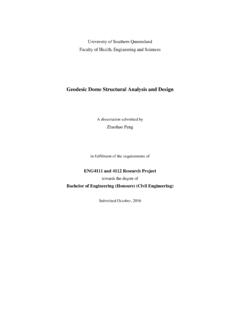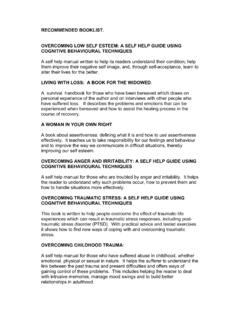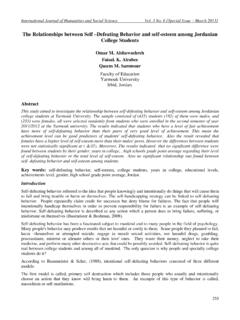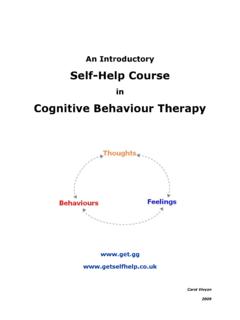Transcription of Overcoming the “shame” factor: Empowering …
1 Sharon Louth Page 1 Overcoming the shame factor: Empowering indigenous people to Share and Celebrate Their Culture Sharon Louth University of Southern Queensland Abstract This paper explores the tenuous relationship between indigenous perspectives and educational institutions. It discusses the importance of developing respectful dialogue between the two, along with the fundamental necessity of working within a community as opposed to upon it. These principles are demonstrated through the creation of a joint community cultural celebration involving local indigenous communities, schools and their University. An evaluation of the event demonstrated how knowledge was enhanced and respectful relationships developed.
2 The project birrbam burunga gambay to play and learn together, involved over 350 people who participated in a shared cultural experience, where indigenous perspectives were showcased by people within the local community. The project stimulated a sense of pride within the indigenous people because their traditional knowledge was valued and respected by the local community. The result was a sense of connectedness for indigenous people with the university and local schools, which arose from the close communication and consultation the project embodied. Respect for indigenous people and their traditional knowledge and skills were shown by the local community at the cultural event. By Overcoming the shame factor, birrbam burunga gambay has empowered indigenous people to share and celebrate their culture with the wider community.
3 Keywords: indigenous perspectives, education, culture, connectedness, cultural celebration, sharing culture, reconciliation Introduction As the need to embed indigenous perspectives grows within our educational institutions (Queensland Government, 2008), the practicalities of achieving this have not yet begun to emerge. The effect of embedding indigenous perspectives at a local level, rather than as an add-on to policy, on the educational achievement of indigenous children is yet to be explored. In addition to this, the effect of embedding indigenous perspectives on the educational achievement of indigenous children requires a meeting of cultures within and outside of the classroom. For many years indigenous people have been seen as underachievers in school and this has led to a limited number of career choices after formal secondary schooling.
4 To change this outlook for indigenous people , government policies to embed indigenous perspectives have been put into place in schools (Australian National Curriculum Board, 2009; Queensland Government, 2008). The onus has been placed on the classroom teachers to provide opportunities for children to learn about indigenous culture in order to recognise indigenous Sharon Louth Page 2 perspectives and foster respect for indigenous people and knowledge (Australian National Curriculum Board, 2009). Many teachers have the appropriate pedagogical skills and attitudes to embed indigenous perspectives, but are hesitant to do so as they feel they lack the knowledge needed to do this effectively (Cummins, Gentle, & Hull, 2008).
5 The solution maybe, is to encourage indigenous peoples to share and celebrate their culture with educators to increase understanding and enhance the future health and well-being for all. This leads to the next question of how indigenous knowledge is shared sensitively and respectfully within local communities and what effect will this have on the educational aspirations of young indigenous children? Literature Review Learning to value one s self is a critical tool in enhancing self - esteem and raising one s aspirations for the future (Bandura, 1977a). This may be of a personal or professional nature, in an academic or social context. Children and adolescents develop their sense of self based upon a range of perceptions they amass from others and their experiences.
6 self - esteem is affected by the social context and social comparisons an individual makes (Sigelman & Rider, 2009). When the terms race and culture are used as a form of social comparison, it can typically marginalize some people , whilst providing others with power and control (McMaster & Austin, 2005). The post-invasion history of Australia s indigenous peoples is chequered with racial discrimination, oppression and marginalisation which have occurred across several generations. The long-term negative impact of this on Australia s indigenous people can be seen in the areas of health and education (Andersen & Walter, 2010). Poor health impedes attendance at school, which in turn inhibits learning and educational achievement (Harrison, 2011).
7 This then perpetuates the cycle of poverty and disadvantage within the indigenous population. As self - esteem is affected by the social context and social comparisons available (Bandura, 1977b), it should come as no surprise to understand how both individual and collective self - esteem of Australia s indigenous peoples is low. self - esteem , self -confidence and self -concept are all words that are sometimes used as inter-related terms or synonyms to describe the same phenomena. However, these terms possess fundamental differences; hence a clear definition of these terms is required. This study determines self -concept as one s perceptions of one s traits as a person, while self - esteem as one s evaluation of one s worth as a person (Sigelman & Rider, 2009).
8 self -confidence relates to how assured one feels about particular abilities, so this can change depending upon the ability under examination, and the group in front of whom the ability is to be demonstrated (McClelland, Atkinson, Clark, & Lowell, 1953). self - esteem is related to self -confidence, which also affects motivation to improve performance (Woods, 2001). The McClelland-Atkinson Model of Achievement Motivation (McClelland, Atkinson, Clark, & Lowell, 1953), means for indigenous people that their behaviour in educational settings is often driven by the motivation to avoid failure rather than seek success. This extends to dodging embarrassment caused by making a mistake in front of a group of people .
9 This is often referred to as avoiding shame . This greatly influences self -confidence and self - esteem , as it dominates how many Aboriginal children think, talk and behave in the classroom (Harrison, 2011, ). For indigenous people , the avoidance of shame is often exhibited in their behaviour (Hughes, More, & Williams, 2004). For example, they may be hesitant to have a go at something in public unless they know they have got it right. They may appear unenthusiastic to cover their fear and vulnerabilities. Furthermore, how they behave in an educational context is very much dependent Sharon Louth Page 3 upon who is looking and listening to them (Harrison, 2011). Contemporary education theories rely upon the learner taking risks and evaluating the outcomes (McGee & Fraser, 2011).
10 indigenous people will approach these gradually and can often get left behind as a result. The lower educational achievement of indigenous students then perpetuates the cycle of decline in their educational attainment. Many educational institutions within Australia have made policy changes to curriculum relating to indigenous perspectives, in an effort to heighten awareness of indigenous culture in our society. The Melbourne Declaration on Educational Goals for Young Australians (MCEETYA, 2008) has made a commitment to improving educational outcomes for indigenous youth, especially those from low socio-economic backgrounds. The Queensland Government has similarly pledged to embed indigenous perspectives within the curriculum (Queensland Government, 2008) in order to improve educational outcomes for indigenous peoples.


















